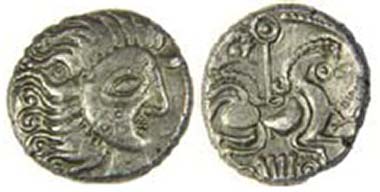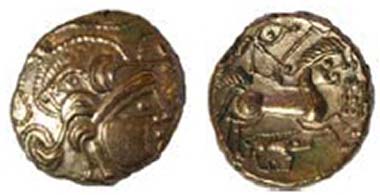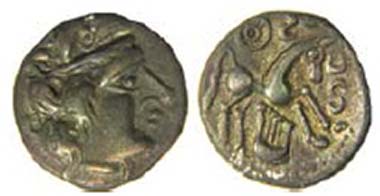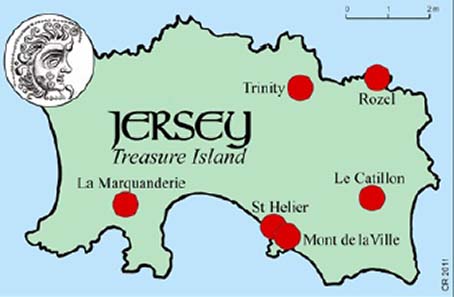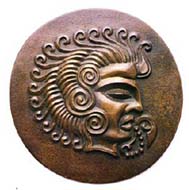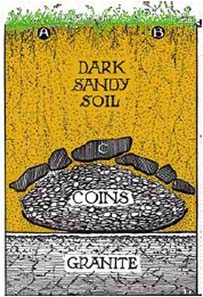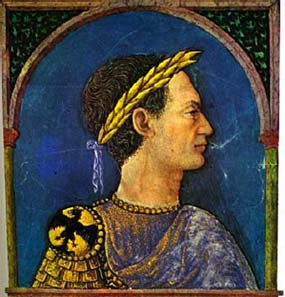by Chris Rudd
Jersey Post has just issued stamps featuring six iron age coins – three Armorican, three British – from a hoard found at Le Catillon, Jersey, in 1957.
New stamps with coins from Le Catillon hoard, Jersey, 1957, mostly minted around time of Gallic War, c.60-50 BC, possibly by chieftain in Jersey (37p), by Durotriges in Dorset (49p), by Baiocasses in Calvados (59p), by Belgae in Hampshire (64p), by Regini in Sussex (79p) and by Coriosolites in Côtes-d’Armor (86p). Source: Jersey Post.
Created by Andrew Robinson, these six stamps are the second issue in Jersey Post’s archaeology series, originated by philatelic researcher Melanie Gouzinis with the help of Olga Finch, curator of archaeology for Jersey Heritage.
Jersey Moon Head base-silver stater, DT 2276, c. 60-56 BC. Lunate head has three-ring tattoo on cheek. Horse has sun-sceptre above, lyre-shape below. La Hougue Bie Museum, Jersey. Source: Olga Finch, Jersey Heritage.
“Over 2,500 coins were found in 1957” says Mrs Finch.
Baiocasses Boar base-gold stater, DT 2254, c. 60-50 BC. Boar above head, cords around. Horse has human head, boar standard below, flag before. La Hougue Bie Museum, Jersey. Source: Olga Finch, Jersey Heritage.
“The coins represented tribes in Armorica, Gaul and southern Britain. Their discovery provided evidence for expanding trade networks between France and England during the late iron age. The Channel Islands would have been convenient stopping places for ships along the route from Alet (St Malo, France) to Hengistbury (Dorset).”
Sussex Lyre silver unit, ABC 647, c. 55-40 BC. Head copied from Aedui of central Gaul. Horse has sun-wheel above, lyre below, S-shapes above and before. La Hougue Bie Museum, Jersey. Source: Olga Finch, Jersey Heritage.
Archaeologist Sir Barry Cunliffe, who has excavated at Hengistbury and in Brittany, says: “Exactly how the process of cross-Channel trade was articulated it is difficult to say, but the exceptionally large quantity of Armorican pottery at the port of Hengistbury hints at the possibility of a significant presence of Armoricans. One possibility, therefore, is that Armoricans actually lived at Hengistbury during the summer months when the trading enterprises were under way and were visited there by Britons bringing products from various parts of central southern and south-western Britain” (Iron Age Communities in Britain, 4th ed. 2005, p.479).
Eight iron age hoards totalling maybe 17,000-20,000 coins have been found in Jersey. And ‘moon-head’ staters were possibly struck in Jersey, says Dr Philip de Jersey. Map shows location of main hoard sites. Source: Chris Rudd.
Jersey has proved to be a veritable treasure island for Celtic coins. It has been estimated that over the past 225 years maybe as many as 20,000 late iron age coins have been discovered in Jersey. This is an amazing stash of cash for an island of only 45 square miles – a third the size of the Isle of Wight. Even more surprising, not one of the eight Jersey treasure hoards I’m going to tell you about was found by metal detectorists. This is all the more remarkable when you consider that over 80 per cent of the 50,000 iron age coins recorded by the Celtic Coin Index at Oxford have been found by metal detectorists.
My Jersey treasure trail begins on a hill overlooking the capital, St Helier. In 1786-87, during the construction of Fort Regent, “un grand nombre de médailles gauloises armoricaines” – perhaps a scattered hoard of Coriosolite staters – were found among the stones of the Mont de la Ville megalith.
The second hoard also came from St Helier. Around 1795 about 200 coins, mostly of the Coriosolites, were unearthed “in an iron pot in a field near the great harbour, Jersey.” 32 of these were given to the British Museum in 1846.
Coriosolite sun-god with wave-like curls of hair and sacred ‘speech scroll’ coming from mouth. Bronze medallion by Major N.V.L. Rybot. Source: A.L.T. McCammon, Currencies of the Anglo-Norman Isles, Spink 1984.
Around 1802 or 1807 “a considerable quantity of Celtic medals [Armorican staters] were found together in an old earthen vase near the harbour of Rozel.” These included staters of the Osismii ‘the last ones’ who lived in the ‘last’ part (extreme northwest) of Gaul, the Baiocasses ‘with blond curls’ who gave their name to Bayeux, and the Coriosolites ‘army of the sun’ whose name survives in Corseul.
In 1820 a cliff fall near Trinity revealed a hoard of 982 mostly Coriosolite staters. The whole hoard was acquired by Baron de Donop who illustrated 760 of the coins in a book dedicated to Queen Adelaide, consort of King William IV of England.
In 1875, after heavy rain, land-slips resulted in two or more Gaulish hoards being discovered near the Castel de Rozel in the northeast corner of ‘treasure island’. There were probably well over 1,000 coins in all, more than 700 of which were recorded. Some went to museums and some may have gone to Sir John Evans, the father of ancient British coin studies. Others may still be in private Jersey collections.
In 1883 a small earthenware pot was found at Rozel, close to the site of former discoveries. It contained a mixture of 18 Coriosolite and Roman coins, the latest identifiable one being of Mark Antony, c. 32 BC.
At La Marquanderie almost 12,000 staters were found with remains of a bronze vessel. Source: N.V.L. Rybot, Armorican Art, Société Jersaise, 1952.
On 22 April 1935, while digging the foundations for a house at La Marquanderie, St Brelade, Mr W. Auffrey discovered one of the biggest Celtic coin hoards of all time – nearly 12,000 Armorican base-silver staters, virtually all of them Coriosolite. “They looked like a lot of old buttons” he said. The owner of the property, Mr Percy Ellis, donated the hoard to the Société Jersiaise and it was published by Major N.V.L. Rybot in his superbly illustrated article ‘Armorican Art’ (Bulletin of La Société Jersiaise 13, 1937, p.153-190). A brilliant example of how an honest finder, a generous landowner, a talented amateur and an enlightened local society can make an enduring contribution to the science of numismatics.
“In January 1957, a large boulder, for years a hazard to ploughs, was lifted from a field at Le Catillon de Haut, Grouville” says Antony McCammon. “Beneath the boulder, together with the fragments of three bronze fibulae, two small rings, some 10 mm of metal braid and the remains of at least three earthenware pots, a mass of coins was found.” This hoard (including another found nearby in 1959) – the hoard showcased by Jersey Post – is estimated to have comprised over 2,500 coins, most of them base-silver staters of the Coriosolites. Though a quarter the size of the La Marquanderie hoard, the Le Catillon hoard is numismatically more important because its mixed contents have enabled scholars to date several uninscribed British types more accurately.
Julius Caesar, ‘Butcher of Brittany’, slaughtered a million Gauls and enslaved a million others. Why do we idolise him? Source: From a manuscript of Plutarch’s Lives, c. 1450.
The vast majority of the estimated 17,000 to 20,000 iron age coins found in Jersey were issued by the Coriosolites of Armorica ‘country by the sea’, which included Brittany, lower Normandy, almost all of Pays de la Loire, and the Channel Islands. I believe that most of these staters of the Coriosolites were struck during the Gallic War to finance resistance to the savage invasion of Julius Caesar. Why else would so many staters have been minted around this time? Surely not for trade.
Caesar’s six years of violence and violation in Gaul were inexcusably cruel and, by today’s standards, worthy of a war crimes tribunal. For example, when the Veneti of Armorica surrendered to Caesar in 56 BC “he had all their councillors executed and the rest of the population sold as slaves.” His words, not mine.
For their help I thank Philip de Jersey, Olga Finch, Daniel Gayet, Melanie Gouzinis, Caroline Holmes, Antony McCammon, Philip Skingley and Pauline Syvret.
by courtesy of Chris Rudd
For more information on Chris Rudd or to read some of his articles, visit its website.
The new stamps are available online from JerseyStamps.






